Yrys
Army.ca Veteran
- Reaction score
- 11
- Points
- 430
Why do we need oil painters in a war zone?, By Finlo Rohrer, BBC News Magazine
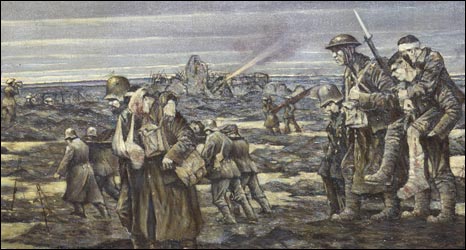
War is a fertile ground for artistic inspiration
It might seem strange that the government would fly a group of artists out
to a war zone, but paintings from Afghanistan are the latest in a long line of
war art that apparently serves a purpose.
Once upon a time artists were sent to wars because the people back home had
no other way of knowing what was going on. In the 19th Century the role of war
art intensified as interest in the conduct of war intensified. When the Crimean War
broke out, the public back in the UK were hungry not just for the outcome of battles,
but how the battle was fought, who did what, and what it looked like.
With photography in its infancy, that meant sending painters and illustrators, and
the likes of Edward Angelo Goodall and Constantin Guys, whose work was published
in newspapers, shaped the British public's view of the war. In later wars even after
the advent of more convenient cameras, artists still retained a role. Artists went
where no camera could be taken.
A soldier who had been running between trenches in WWI could paint his experiences
on his return, while carrying a camera would have been impossible. And the feted
illustrator Ronald Searle was one of a number of British servicemen who recorded
their experiences after being captured by the Japanese in WWII. But in the era of
blanket photographic and video coverage of the wars which Western powers are
involved in, why are war artists still needed?
Sharpened skills
Painter Jules George recently visited Afghanistan, as part of a group of artists taken
by the MoD and attached to military units. Mr George has always wanted to paint
on a military theme. "I was going to join the army when I was a lot younger, but
made the decision to pursue my art. I thought it would be interesting to combine
my interests with my art."
After contacting the Ministry of Defence and being selected for the trip, he paid for
hostile environments training and looked to his art. "I did a lot of drawing to sharpen
up my skills," he admits. Soon he was on a plane and deployed with 2nd Battalion,
The Yorkshire Regiment (Green Howards), and able to witness a firefight with them,
out on patrol.
"I was on the top of a Mastiff [armoured vehicle] and we had a few rounds shot at us.
I witnessed the whole skirmish."
The convoy was hit by a blast, said at the time to be either a mortar round or a
radio-controlled IED. It gave Mr George a chance to convey what life at the sharp
end was like. After two weeks he had filled five sketch books.
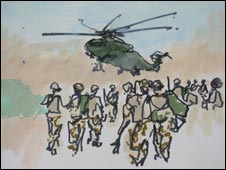
Unique perspective
"On a trip like this it is best to do rapid fire sketches, with movement. I used my
drawing book like a camera. I rely very much on the power and energy of the initial
drawing." But why is art necessary in a war?
Graeme Lothian, who was sent on the same trip as Jules George, has a unique perspective.
Decades ago he was a commando before breaking his back. He sees the artists' purpose as
complementary to the journalists and historians who will also chronicle the war. "It's good
to stand there and take a step back and just look at the Army from a distance. This will be
history one day, Camp Bastion will be dust. We are painting history."
And he believes the very act of deploying artists to Afghanistan shows progressive thinking
on the part of the MoD. "The Army have always said no to artists, now they are changing
their mind. There is a sea change that artists are important."
Of course, there would be some who might accuse these artists of being part of an effort
to produce propaganda. "You could say that," says Mr George. "Then equally I'm very free
within my own role to produce what I think are poignant images. The rights and wrongs,
that is not something I want to inquire about. It is the actual fact of the soldiering."
The issue of propaganda was also wrestled with during the world wars - both of which saw
the deployment of artists picked by the British military. But look at paintings from World
War I and it's hard to see the "propaganda" value. John Singer Sargent's Gassed, from
the immediate aftermath of the war, shows a line of blindfolded soldiers, linked, and slowly
moving through a foreground of dozens of other injured soldiers. In an instant it portrays
the grim toll of the war.
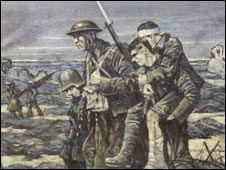
CRW Nevinson's The Harvest of Battle
is at the Imperial War Museum
CRW Nevinson's The Harvest of Battle, also from the end of the war, shows soldiers moving
gingerly through a hellish scene of filthy ponds made by shell blasts, contorted bodies and
scraps of barbed wire. Paul Nash, who painted both unofficially and officially in the wars,
is responsible for a number of powerful images.
The Mule Track (1918) shows the sheer terrifying power of a WWI barrage, while The Ypres
Salient at Night shows the illumination of an eerie section of the front.
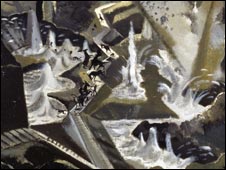
Paul Nash's The Mule Track is on display
at the Imperial War Museum
Growing interest
But perhaps the most startling message in his work is We Are Making a New World, echoing
the tone of war propaganda. The "new world" shown in the painting is a hellish, blasted scene,
with trees denuded of leaves. Nash's work is currently being featured in an exhibition in London
and his stock is rising, with big sums being paid for his work at auction. It's part of a growing
interest in war art, says Richard Slocombe, a curator at the Imperial War Museum.
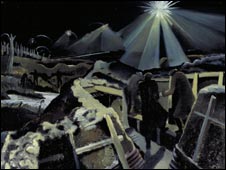
"On the most basic level it is to make some sort of record of the conflict. On a higher level it is
a way of interpreting a conflict. A lot of artists feel moved to create art as a way to exploration
of the emotions of war."
Nash's story was noteworthy in that he started painting as an ordinary infantryman at the
front, was injured, and returned to the front as an officially-sponsored war artist. Even with
the authorities' endorsement, he pulled no punches. The powers-that-be wouldn't have
minded getting back grim images from the front, says Mr Slocombe.
"It wasn't so much what they painted. It was the fact that Britain was commissioning young
artists and allowing them to express themselves. Britain was fighting the war to safeguard
individual expression and personal liberty. Germany was this autocratic system setting out
to suppress liberal freedoms." There is an echo of this attitude today.
"What they see, they are entitled to paint," says Lt Col Kevin Stratford, who organised the artists'
trip. "We are accountable. What we do isn't a secret. It is in the media every day because the MoD
is helping it be there." And the artists argue that what they are doing is different to the mass media.
"When Afghanistan has gone and finished the next generation won't understand. It is important to
record it," says Mr George.
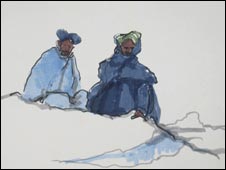
Much of the Imperial War Museum London's war art collection can be seen in the current
Breakthrough exhibition. Paul Nash: The Elements can be seen at Dulwich Picture Gallery
in London until 9 May.
Imperial War Museum London
War shapes lives
Dulwich Picture Gallery:
Paul Nash: The Elements
The Wyeth Family: Three Generations of American Art

War is a fertile ground for artistic inspiration
It might seem strange that the government would fly a group of artists out
to a war zone, but paintings from Afghanistan are the latest in a long line of
war art that apparently serves a purpose.
Once upon a time artists were sent to wars because the people back home had
no other way of knowing what was going on. In the 19th Century the role of war
art intensified as interest in the conduct of war intensified. When the Crimean War
broke out, the public back in the UK were hungry not just for the outcome of battles,
but how the battle was fought, who did what, and what it looked like.
With photography in its infancy, that meant sending painters and illustrators, and
the likes of Edward Angelo Goodall and Constantin Guys, whose work was published
in newspapers, shaped the British public's view of the war. In later wars even after
the advent of more convenient cameras, artists still retained a role. Artists went
where no camera could be taken.
A soldier who had been running between trenches in WWI could paint his experiences
on his return, while carrying a camera would have been impossible. And the feted
illustrator Ronald Searle was one of a number of British servicemen who recorded
their experiences after being captured by the Japanese in WWII. But in the era of
blanket photographic and video coverage of the wars which Western powers are
involved in, why are war artists still needed?
Sharpened skills
Painter Jules George recently visited Afghanistan, as part of a group of artists taken
by the MoD and attached to military units. Mr George has always wanted to paint
on a military theme. "I was going to join the army when I was a lot younger, but
made the decision to pursue my art. I thought it would be interesting to combine
my interests with my art."
After contacting the Ministry of Defence and being selected for the trip, he paid for
hostile environments training and looked to his art. "I did a lot of drawing to sharpen
up my skills," he admits. Soon he was on a plane and deployed with 2nd Battalion,
The Yorkshire Regiment (Green Howards), and able to witness a firefight with them,
out on patrol.
"I was on the top of a Mastiff [armoured vehicle] and we had a few rounds shot at us.
I witnessed the whole skirmish."
The convoy was hit by a blast, said at the time to be either a mortar round or a
radio-controlled IED. It gave Mr George a chance to convey what life at the sharp
end was like. After two weeks he had filled five sketch books.

Unique perspective
"On a trip like this it is best to do rapid fire sketches, with movement. I used my
drawing book like a camera. I rely very much on the power and energy of the initial
drawing." But why is art necessary in a war?
Graeme Lothian, who was sent on the same trip as Jules George, has a unique perspective.
Decades ago he was a commando before breaking his back. He sees the artists' purpose as
complementary to the journalists and historians who will also chronicle the war. "It's good
to stand there and take a step back and just look at the Army from a distance. This will be
history one day, Camp Bastion will be dust. We are painting history."
And he believes the very act of deploying artists to Afghanistan shows progressive thinking
on the part of the MoD. "The Army have always said no to artists, now they are changing
their mind. There is a sea change that artists are important."
Of course, there would be some who might accuse these artists of being part of an effort
to produce propaganda. "You could say that," says Mr George. "Then equally I'm very free
within my own role to produce what I think are poignant images. The rights and wrongs,
that is not something I want to inquire about. It is the actual fact of the soldiering."
The issue of propaganda was also wrestled with during the world wars - both of which saw
the deployment of artists picked by the British military. But look at paintings from World
War I and it's hard to see the "propaganda" value. John Singer Sargent's Gassed, from
the immediate aftermath of the war, shows a line of blindfolded soldiers, linked, and slowly
moving through a foreground of dozens of other injured soldiers. In an instant it portrays
the grim toll of the war.

CRW Nevinson's The Harvest of Battle
is at the Imperial War Museum
CRW Nevinson's The Harvest of Battle, also from the end of the war, shows soldiers moving
gingerly through a hellish scene of filthy ponds made by shell blasts, contorted bodies and
scraps of barbed wire. Paul Nash, who painted both unofficially and officially in the wars,
is responsible for a number of powerful images.
The Mule Track (1918) shows the sheer terrifying power of a WWI barrage, while The Ypres
Salient at Night shows the illumination of an eerie section of the front.

Paul Nash's The Mule Track is on display
at the Imperial War Museum
Growing interest
But perhaps the most startling message in his work is We Are Making a New World, echoing
the tone of war propaganda. The "new world" shown in the painting is a hellish, blasted scene,
with trees denuded of leaves. Nash's work is currently being featured in an exhibition in London
and his stock is rising, with big sums being paid for his work at auction. It's part of a growing
interest in war art, says Richard Slocombe, a curator at the Imperial War Museum.

"On the most basic level it is to make some sort of record of the conflict. On a higher level it is
a way of interpreting a conflict. A lot of artists feel moved to create art as a way to exploration
of the emotions of war."
Nash's story was noteworthy in that he started painting as an ordinary infantryman at the
front, was injured, and returned to the front as an officially-sponsored war artist. Even with
the authorities' endorsement, he pulled no punches. The powers-that-be wouldn't have
minded getting back grim images from the front, says Mr Slocombe.
"It wasn't so much what they painted. It was the fact that Britain was commissioning young
artists and allowing them to express themselves. Britain was fighting the war to safeguard
individual expression and personal liberty. Germany was this autocratic system setting out
to suppress liberal freedoms." There is an echo of this attitude today.
"What they see, they are entitled to paint," says Lt Col Kevin Stratford, who organised the artists'
trip. "We are accountable. What we do isn't a secret. It is in the media every day because the MoD
is helping it be there." And the artists argue that what they are doing is different to the mass media.
"When Afghanistan has gone and finished the next generation won't understand. It is important to
record it," says Mr George.

Much of the Imperial War Museum London's war art collection can be seen in the current
Breakthrough exhibition. Paul Nash: The Elements can be seen at Dulwich Picture Gallery
in London until 9 May.
Imperial War Museum London
War shapes lives
Dulwich Picture Gallery:
Paul Nash: The Elements
The Wyeth Family: Three Generations of American Art

